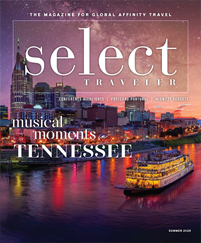Arkansas, known at the Natural State for its outdoor attributes, is full of character — and full of characters, too.
Rolling across the state can introduce you to a country music star and an interplanetary traveler in the Delta flatlands, to a president in a major river city and the spirits of gangsters in a spa city, and to folk artists and fine artists in the mountains.
Arkansas is a fairly compact place. It’s less than 300 miles east to west and about 250 miles north to south, but don’t assume there are that many straight-line highways in a state where major rivers and two mountain ranges — the Ozarks and the Ouachitas — create some curvy and beautiful routing.
In the Delta
The flat Delta farmland in eastern Arkansas produces cotton, soybeans and rice, along with memories of two internationally famous entertainment figures. This was the boyhood home of Johnny Cash of country music fame and the unfortunate forced-internment home of George Takei of “Star Trek” fame.
North of West Memphis, the Dyess Colony was an agricultural resettlement community created to give a fresh start to 500 impoverished Arkansas families. One was the Cash family, which arrived in 1935 with 3-year-old JR, later called Johnny. It was one of Franklin Roosevelt’s Depression-era recovery efforts.
Today, you can see the simple home that sheltered Cash. Inside is a piano that Cash’s mother, Carrie, played to lift family spirits after long days in the cotton fields. The experience undoubtedly shaped Cash’s love of music and story. Nearby, the Dyess Colony Visitors Center explains the New Deal project’s scope.
Farther south, almost equidistant between Pine Bluff and Greenville, Mississippi, is a place with a much darker story. It is the site of World War II’s Rowher and Jerome internment camps that held Japanese-American families. One of those families contained by barbed wire fences and armed guards was that of George Takei, who decades later steered the Starship Enterprise for Captain Kirk.
Today, you can tour the grounds where the Rowher camp once existed and sense the isolation. It is on the National Register of Historic Places and is a National Historic Landmark. There’s not much left, only a couple of monuments in a cemetery. One commemorates Japanese-Americans who fought for the U.S. in Anzio, elsewhere in Italy and in France during the war. Thirty-one from Rohwer died in action, and their names are here.
Begin your exploration in nearby McGehee at the Jerome-Rohwer Interpretive Museum. Then take the recorded walking tour, narrated by Takei.
Little Rock and North Little Rock
Little Rock and North Little Rock, connected by a trolley ride over the Arkansas River, are a trove of activities — indoors, outdoors and almost underwater.
Little Rock’s big attraction is the Clinton Presidential Library and Museum, which sits high above the Arkansas River and at the foot of the Clinton Presidential Park Bridge, a pedestrians-only crossover. Regardless of anyone’s political leaning, the library and museum provide a snapshot into eight years of American history.
Highly inviting museum displays chronicle the news-packed Clinton years — everything from international strife — war in the Balkans — to domestic strife — Clinton’s impeachment. Artifacts, photos, documents and videos tell the stories, including one popular reel of presidential humor highlights. Added amusement comes from viewing some of the odd gifts Clinton received. Among them are a baseball bat Hank Aaron autographed, a carpeted treehouse for the presidential cat and an Elvis-at-the-piano cookie jar. Take your own souvenir picture in a replica of the Oval Office.
The Clinton Bridge has added importance because it is part of a 14.2-mile loop of the Arkansas River Trail on both sides of the river. Active groups can rent bicycles at the nearby River Market and pedal to the Big Dam Bridge — that’s its real name. An alternative is strolling through the 11-block-long Riverfront Park. Among its attractions is a view of the “Little Rock” that gave the city its name.
North Little Rock destinations are the Argenta Arts District, which includes art galleries, chef-driven restaurants and bars, a farmers market, shops, a monthly art walk and live entertainment venues, and the perhaps unexpected Arkansas Inland Maritime Museum, with two vessels that bookended World War II. On December 7, 1941, the USS Hoga, a tugboat, pushed the damaged USS Nevada out of the mouth of Pearl Harbor, and the USS Razorback, a submarine, was in Tokyo Bay the day Japan surrendered.
Mountain Home
Head north from Little Rock into the hills for the quintessential Arkansas experience, visiting the Ozark Folk Center State Park in Mountain View. Here, among musicians, artists and crafters who perpetuate the mountain folkways, lives the spirit of Jimmy Driftwood, the high school teacher who wrote “The Battle of New Orleans” to help his students learn history, performed at Carnegie Hall and was on the advisory committee to the Kennedy Center for the Performing Arts in Washington, D.C.
Driftwood, who died in 1998, helped inspire the creation of the Ozark Folk Center and would feel right at home with the quilters, soap-makers, potters, weavers, jewelry-makers, leatherworkers and carvers who demonstrate their skills and lead workshops. He would understand the Heritage Herb Garden and the importance of the medicinal and edible herbs that grow there. He would revel in the music that flows from the park’s 1,000-seat theater, whether the performers were folks with day jobs or big-name celebrity stars. For a dose of the music, find tracks from “Ozark Highlands Radio,” a weekly show from the park.
While in the neighborhood, take in more entertainment at the Jimmy Driftwood Music Barn, which authentically celebrates Driftwood’s spirit on Friday and Sunday nights during prime travel months. A cool summertime option is 15 miles up the highway at Blanchard Springs Caverns, a living cave, meaning that formations are still growing. It is administered by the USDA Forest Service and is always about 55 degrees Fahrenheit.
Hot Springs
Characters to encounter in the spa city of Hot Springs range from Hernando de Soto and Andrew Jackson to Babe Ruth and Al Capone. How’s that for a mixed bag? This “Valley of the Vapors” in the Ouichata Mountains was neutral turf for Native Americans, who recognized the healing properties of naturally flowing hot springs — 143 degrees Fahrenheit — long before Spanish explorer de Soto ambled by in 1541. Jackson designated the area the first federal reservation in 1832.
As the 19th century progressed, a spa industry evolved, culminating in construction of resort hotels — the Arlington is practically legendary — and fancy Victorian bathhouses. The center of town became a national park in 1921, and the Fordyce Bathhouse now is the park service’s visitor center. As the 2021 centennial of the national park nears, you still can “take the waters” at some Bath House Row locations. The Backstaff Bathhouse, built in 1912, is the oldest in continuous operation.
And what about Ruth and Capone? They didn’t hang out together, but early baseball teams congregated here for training and treatment, and Hot Springs had a notorious gangster era when Capone and others found virtual sanctuary. Hot Springs was calmer and greener than Chicago. Learn more about both through the Hot Springs Historic Baseball Trail and the Gangster Museum.
Check out the newly opened Crystal Ridge Distillery, just a mile from Bath House Row, which has adapted a 1920-vintage mercantile building into a distillery and group-friendly restaurant. Owners proclaim their goal is “paying homage to the roots of Arkansas moonshine,” but they go beyond white lightning to produce flavored moonshines, bourbon and vodka.
Eureka Springs and Bentonville
Eureka Springs, where the entire downtown is on the National Register of Historic Places, took the early lead drawing visitors to northwest Arkansas. The entire region’s popularity has spread and diversified in recent decades, but Eureka Springs remains a magnet with its shops, art galleries, spas and classic hotels such as the 1886 Crescent Hotel and Spa. The Crescent is an icon in Arkansas hospitality, and among its claims to fame is being labeled “America’s most haunted hotel.” Yes, ghost tours here and elsewhere in town are popular.
Just as you might not have expected a submarine in North Little Rock, you might not expect a sanctuary for abandoned, abused and neglected lions, tigers and other exotic big cats in Eureka Springs. However, that’s what the Turpentine Creek Wildlife Refuge is. It operates in stark contrast to a recent television series that thrust big cats into visibility.
The business community knows Bentonville because of its connection to Walmart, but Alice Walton, daughter of retail icon Sam Walton, made sure that art lovers know this Ozark town, too. Alice endowed the Crystal Bridges Museum of American Art, which is within walking distance of downtown, making it easy for guests at the 21c Museum Hotel and other properties to see works by Thomas Hart Benton, Gilbert Stuart, Georgia O’Keeffe, Andy Warhol and others.
New in early 2020 and a satellite of Crystal Bridges is the Momentary, which transformed a decommissioned cheese factory into a space for visual and performing arts, culinary experiences, festivals and more. The Momentary’s mission is to champion contemporary art in everyday life. It is an expansive 63,000-square-foot facility with abundant spaces indoors and outside in the Arkansas sunshine.









